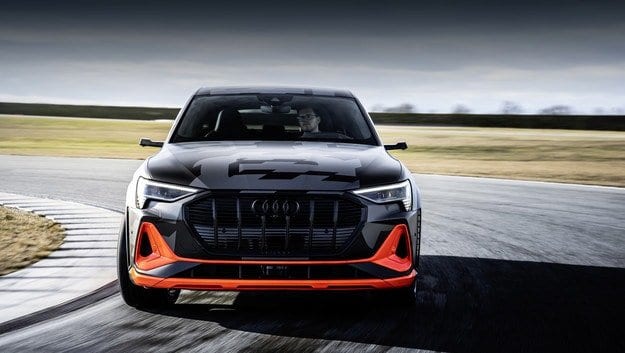
Disclosed aerodynamics of the crossover Audi e-tron S

Sophisticated aerodynamics allow you to travel more kilometers without recharging.
The German company Audi, as you know, is preparing to release the most powerful version of the e-tron, an electric crossover e-tron S and a trimotor with two bodies: regular and coupe. Compared to the twin-engine counterparts of the e-tron and e-tron Sportback, the S version has a change in appearance. For example, the wheel arches are widened by 23 mm on each side (the track is also increased). Such an additive should theoretically degrade aerodynamics, but engineers have taken a number of measures to keep it at the level of the original e-tron modifications. For this, a system of channels in the front bumper and wheel arches has been created, which direct the air in such a way as to optimize the flow around the wheels.
Sophisticated aerodynamics allow you to drive more kilometers with one allowance, although the main charm of this version is not at all in economy. The total peak power of the electric drive system here is 503 hp. and 973 Nm. Although the car is quite heavy, it is capable of accelerating from 100 to 4,5 km / h in XNUMX seconds.
There are two air ducts on each side. One runs from the side air intakes in the bumper, the other from a gap in the wheel arch linings. The combined effect is that behind the front arches, that is, on the side walls of the body, the air flow becomes calmer.
As a result of these measures, the drag coefficient for the Audi e-tron S is 0,28, for the Audi e-tron S Sportback - 0,26 (for the standard e-tron crossover - 0,28, for the e-tron Sportback - 0 ). Further improvement is possible with additional virtual SLR cameras. The Germans do not specify the coefficients, but they write that such mirrors provide an electric vehicle with an increase in mileage on a single charge by three kilometers. In addition, at high speeds, the air suspension here reduces the ground clearance by 25 mm (in two stages). It also helps to reduce air resistance.
To further improve aerodynamics, a splitter, smooth underbody flaps with recessed attachment points, a spoiler, 20-inch wheels optimized for airflow and even specially patterned sidewalls.
At speeds between 48 and 160 km / h, two sets of louvers close behind the e-tron S radiator grille. They begin to open when more air is required by the air conditioning heat exchanger or the cooling system of the drive component. The separate grooves towards the wheel arches are additionally activated if the brakes start to overheat due to heavy load. It is known that the conventional electric SUV Audi e-tron 55 quattro (peak power 408 hp) is already on the market. It is too early to talk about other versions.
